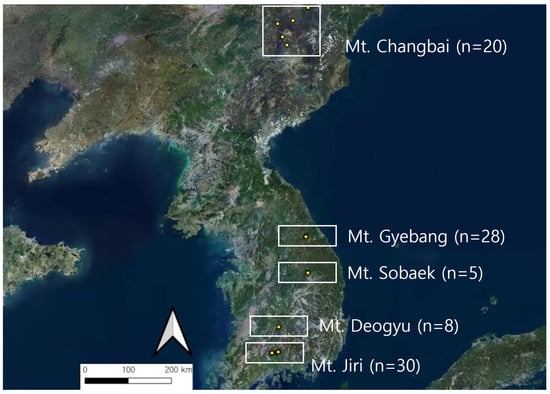Journal Description
International Journal of Plant Biology
International Journal of Plant Biology
is an international, peer-reviewed, open access journal on all different subdisciplines of plant biology, published quarterly online by MDPI (from Volume 13, Issue 1 - 2022).
- Open Access— free for readers, with article processing charges (APC) paid by authors or their institutions.
- High Visibility: indexed within Scopus, Biological Abstracts and BIOSIS Previews (Web of Science), and other databases.
- Rapid Publication: manuscripts are peer-reviewed and a first decision is provided to authors approximately 14.4 days after submission; acceptance to publication is undertaken in 4.7 days (median values for papers published in this journal in the second half of 2023).
- Recognition of Reviewers: APC discount vouchers, optional signed peer review, and reviewer names published annually in the journal.
Latest Articles
Analyzing Generalist Plant Species Using Topographic Characteristics of Picea jezoensis (Siebold & Zucc.) Carrière Forests in East Asia: From China (Mt. Changbai) to South Korea
Int. J. Plant Biol. 2024, 15(2), 320-339; https://doi.org/10.3390/ijpb15020027 - 18 Apr 2024
Abstract
Picea jezoensis (Siebold & Zucc.) Carrière forests are distributed in Korea and China and are crucial for phytogeographical research. Implementing conservation policies encompassing multiple species is necessary to conserve endangered species, particularly monitoring coexisting species and their interactions within an ecological network. Here,
[...] Read more.
Picea jezoensis (Siebold & Zucc.) Carrière forests are distributed in Korea and China and are crucial for phytogeographical research. Implementing conservation policies encompassing multiple species is necessary to conserve endangered species, particularly monitoring coexisting species and their interactions within an ecological network. Here, we identified plants within P. jezoensis forests in East Asia as generalist species to contribute foundational data for biodiversity conservation. We examined 91 standardized sites through the Braun-Blanquet method, while generalist indices were calculated using Levin’s method. The top 5% of generalists in the P. jezoensis forests were Acer komarovii (0.7409), Betula ermanii (0.7214), Asarum sieboldii (0.7002), Lepisorus ussuriensis (0.6977), Acer pseudosieboldianum (0.6915), Tripterygium regelii (0.6876), Thelypteris phegopteris (0.6771), Dryopteris expansa (0.6745), Sorbus commixta (0.6642), and Rhododendron schlippenbachii (0.6625). Correlation analysis between ecological factors and generalist species revealed that the coverage of Abies spp., Acer spp., and Rhododendron spp. and the species diversity index were influenced by altitude. Convex hull analysis revealed that pteridophytes and broad-leaved plants regenerated through stump sprouts occupy ecological niche spaces, indicating diverse habitats within P. jezoensis forests. This study highlights the importance of the simultaneous monitoring of multiple species to conserve ecosystem health and offers broader implications for ecological understanding.
Full article
(This article belongs to the Section Plant Ecology and Biodiversity)
►
Show Figures
Open AccessArticle
Argemone ochroleuca Phytochemicals and Allelopathic Effect of Their Extracts on Germination of Soybean
by
Nezelo T. Mlombo, Zakheleni P. Dube, Fikile N. Makhubu and Hellen Nxumalo
Int. J. Plant Biol. 2024, 15(2), 304-319; https://doi.org/10.3390/ijpb15020026 - 16 Apr 2024
Abstract
Soybean is a high-value food source, and the invasive weeds Mexican prickly poppy (Argemone ochroleuca) could release allelochemicals that inhibit the growth of this crop. The impact of A. ochroleuca on the germination and growth of soybean is not well documented.
[...] Read more.
Soybean is a high-value food source, and the invasive weeds Mexican prickly poppy (Argemone ochroleuca) could release allelochemicals that inhibit the growth of this crop. The impact of A. ochroleuca on the germination and growth of soybean is not well documented. Therefore, the aim of this study was to evaluate the TLC profiles of different extracts of A. ochroleuca and assess the effects of extracts on the germination of soybean seeds. Shoots and roots of A. ochroleuca were weighed and 100 g of each was separately extracted with 1000 mL deionized water, hexane or acetone. Ten concentrations of water extracts ranging from 10 to 100 mL per 100 mL of deionized water and three concentrations of acetone and hexane extracts ranging from 2.5 to 7.5 g/L were separately used for seed germination bioassays. Thin-layer chromatography (TLC) analysis was used to compare the chemical profiles in the shoot and root water, and in the hexane and acetone extracts of A. ochroleuca. The highest reduction was recorded from the water extract, at 100%. The TLC profiling of A. ochroleuca addressed different classes of compounds, including alkaloids, phenolic acids and flavanoids. There is, however, a need to identify the most active phytochemicals in the suppression of germination.
Full article
(This article belongs to the Topic Plant Invasion)
►▼
Show Figures

Figure 1
Open AccessFeature PaperArticle
Menthalactone from Mentha piperita L., a Monocot-Selective Bioherbicide
by
Adam Soltani, Meirambek Ospanov, Zeyad M. A. Ibrahim, Joanna Bajsa-Hirschel, Charles L. Cantrell, James V. Cizdziel, Ikhlas A. Khan and Mohamed A. Ibrahim
Int. J. Plant Biol. 2024, 15(2), 293-303; https://doi.org/10.3390/ijpb15020025 - 11 Apr 2024
Abstract
The challenge of managing invasive weed species continues to affect the agricultural industry, presenting ecological, economic, and agronomic hurdles that lead to over 100 billion USD in annual crop losses globally. One such concern is the management of Agrostis stolonifera L., commonly known
[...] Read more.
The challenge of managing invasive weed species continues to affect the agricultural industry, presenting ecological, economic, and agronomic hurdles that lead to over 100 billion USD in annual crop losses globally. One such concern is the management of Agrostis stolonifera L., commonly known as creeping bentgrass, particularly due to its ability to form hybrids. This scenario underscores the urgent need for innovative, effective, and environmentally sustainable herbicides, steering the focus toward natural substances as potential candidates. We report here a promising natural lactone, commonly known as menthalactone, which is derived from Mentha piperita L. Its phytotoxic activity was assessed against the monocot, bentgrass, and a dicot, lettuce (Lactuca sativa L.). Menthalactone displayed outstanding activity against bentgrass and was further evaluated for phytotoxic characteristics. The germination of A. stolonifera seeds was significantly inhibited with an IC50 value of 4.9 ± 1.2 µM. In contrast to bentgrass seeds, Lemna pausicostata L. plants were less responsive to menthalactone treatment, shown by an IC50 of 293.4 ± 70.6 µM. Both species are monocots, and the results suggest that menthalactone might have effects on seed germination but not on the metabolism of green tissues. The susceptibility of three common, obnoxious weed species, i.e., ryegrass (Lilium perenne), barnyard grass (Echinochloa crus-galli (L.) P. Beauv.), and crabgrass (Digitaria sanguinalis (L.) Scop.), to menthalactone was assessed. Menthalactone at 1000 µM completely inhibited the germination of all three species of grasses, while 330 µM inhibited germination by less than 50%. The post-emergence application of menthalactone at 1% did not produce a significant inhibitory effect against ryegrass, barnyard grass, or crabgrass.
Full article
(This article belongs to the Section Plant Physiology)
►▼
Show Figures
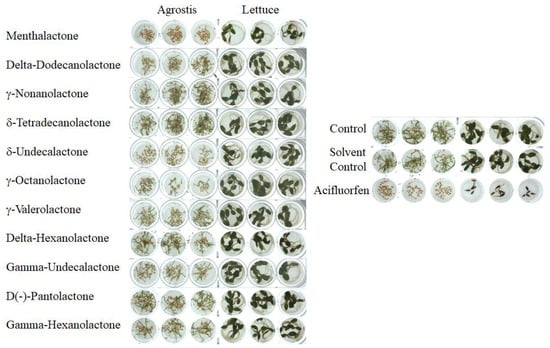
Figure 1
Open AccessArticle
Response of Industrial Hemp (Cannabis sativa L.) to Herbicides and Weed Control
by
Thomas Gitsopoulos, Eleni Tsaliki, Nicholas E. Korres, Ioannis Georgoulas, Ioannis Panoras, Despoina Botsoglou, Eirini Vazanelli, Konstantinos Fifis and Konstantinos Zisis
Int. J. Plant Biol. 2024, 15(2), 281-292; https://doi.org/10.3390/ijpb15020024 - 11 Apr 2024
Abstract
Industrial hemp is a continuously expanding crop; however, there has been limited research on its herbicide selectivity and weed control. Pendimethalin, s-metolachlor and aclonifen at 1137.5, 960 and 1800 g a.i. ha−1, respectively, were applied in field experiments in 2022 and
[...] Read more.
Industrial hemp is a continuously expanding crop; however, there has been limited research on its herbicide selectivity and weed control. Pendimethalin, s-metolachlor and aclonifen at 1137.5, 960 and 1800 g a.i. ha−1, respectively, were applied in field experiments in 2022 and 2023 in Greece to study the response of industrial hemp to pre-emergence (PRE) herbicides and record their efficacy on weeds. In 2023, each PRE herbicide was followed by the postemergence application of cycloxydim at 200 g a.i. ha−1 due to infestation of Sorghum halepense. In 2022, retardation in hemp growth was recorded by all PRE herbicide treatments, with there being a slight reduction in stand counts by pendimethalin and s-metolachlor and leaf yellowing by aclonifen in one the experiments. In 2023, no reductions in crop establishment and plant height were recorded, whereas leaf discoloration caused by aclonifen was less evident; cycloxydim did not affect hemp and perfectly controlled S. halepense. Despite the herbicide injury, hemp recovered and succeeded in higher biomass in both experiments at Thessaloniki and in higher seed production in the 2023 Thessaloniki experiment. This study showed that pendimethalin, s-metolachlor and aclonifen can be regarded as potential pre-emergence options with precautions in wet and light soils.
Full article
(This article belongs to the Section Plant Physiology)
►▼
Show Figures
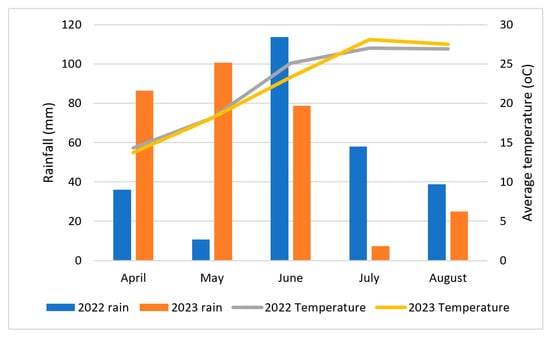
Figure 1
Open AccessArticle
The Genetic Homogeneity of Uganda’s East African Highland Bananas (Mutika/Lujugira) Does Not Match the Extensive Morphological Variation Identified in this Subgroup
by
Michael Pillay
Int. J. Plant Biol. 2024, 15(2), 267-280; https://doi.org/10.3390/ijpb15020023 - 09 Apr 2024
Abstract
The East African Highland banana (Mutika/Lujugira subgroup) is composed of triploid (AAA) cooking and beer banana varieties that are adapted to the high-altitude region of the Great Lakes region of East Africa. Banana production is affected by several biotic and abiotic factors. Breeding
[...] Read more.
The East African Highland banana (Mutika/Lujugira subgroup) is composed of triploid (AAA) cooking and beer banana varieties that are adapted to the high-altitude region of the Great Lakes region of East Africa. Banana production is affected by several biotic and abiotic factors. Breeding opportunities in bananas are limited due to female sterility and parthenocarpy. The genetic diversity of crops enables breeders to develop new germplasm. Molecular markers have been used widely to dissect crop plants’ genetic diversity. This study assessed the genetic variation in 27 varieties from the Mutika/Lujugira subgroup using random amplified polymorphic DNA (RAPD). No genetic variation was observed among the banana varieties, and the 18 ten-mer primers produced monomorphic banding profiles. The genetic homogeneity of this banana subgroup is not congruent with their extensive morphological variation. Domestication and the bottleneck effect are often cited as the cause of reduced diversity in crop plants. On the other hand, several mechanisms, including somatic mutations, transposable elements, polyploidy, genome plasticity, and epigenetic mechanisms, are known to increase plant phenotypic variability. Further in-depth research is needed to explain the puzzle between the genetic and morphological diversity in the Mutika/Lujugira subgroup.
Full article
(This article belongs to the Section Plant Biochemistry and Genetics)
►▼
Show Figures

Figure 1
Open AccessArticle
N6-benzyladenine (BAP)-Based Seed Preconditioning Enhances the Shoot Regeneration of Seedling-Derived Explants for Subsequent Indirect Gene Transfer in Soybeans (Glycine max [L.] Merrill.)
by
Esmerald Michel Khomotso Sehaole and Phetole Mangena
Int. J. Plant Biol. 2024, 15(2), 254-266; https://doi.org/10.3390/ijpb15020022 - 08 Apr 2024
Abstract
This study evaluated the effects of N6-benzyladenine (BAP) seed preconditioning and seedling-derived explants on in vitro plant regeneration potential in soybeans (Glycine max [L.] Merrill.). The findings showed that seed preconditioning with 2.55 mg/L BAP prior to germination significantly influenced
[...] Read more.
This study evaluated the effects of N6-benzyladenine (BAP) seed preconditioning and seedling-derived explants on in vitro plant regeneration potential in soybeans (Glycine max [L.] Merrill.). The findings showed that seed preconditioning with 2.55 mg/L BAP prior to germination significantly influenced seedling establishment and the development of shoots, shoot elongation, and rooting on MS media supplemented with BAP and TDZ, compared to the negative (MS-NC) and positive (MS-NP) controls. The results also showed significant differences based on the genotypes, with Dundee recording 91.0% germination over a minimum of 5 days, compared to 74.2% with Peking, followed by 87.5% and 80.0% overall shoot induction frequency in these genotypes, respectively. Regenerated shoots were successfully elongated on MS medium supplemented with 0.5 mg/L BAP plus 0.6 mg/L GA3 and rooted on hormone-free medium, for 3‒4 weeks, and then hardened in the acclimatization growth room under elevated light levels. Overall, this study revealed that BAP preconditioning of seeds enhances the frequency of bud initiation and shoot proliferation, mostly in whole-seedling and cotyledonary node explants subcultured on MS-E and MS-A media supplemented with BAP in combination with TDZ.
Full article
(This article belongs to the Section Plant Reproduction)
►▼
Show Figures
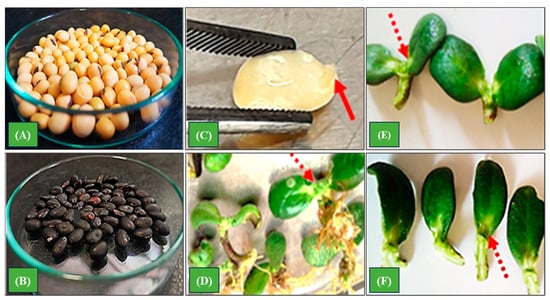
Figure 1
Open AccessCorrection
Correction: Sharma et al. Rhizophagus irregularis and Azotobacter chroococcum Uphold Eggplant Production and Quality under Low Fertilization. Int. J. Plant Biol. 2022, 13, 601–612
by
Meenakshi Sharma, Anil Kumar Delta, Navjot Singh Brar, Alpa Yadav, Parmdeep Singh Dhanda, Marouane Baslam and Prashant Kaushik
Int. J. Plant Biol. 2024, 15(2), 253; https://doi.org/10.3390/ijpb15020021 - 08 Apr 2024
Abstract
In the original publication [...]
Full article
Open AccessArticle
Genomic Prediction of Root Traits via Aerial Traits in Soybean Using Canonical Variables
by
Vitor Seiti Sagae, Noé Mitterhofer Eiterer Ponce de Leon da Costa, Matheus Massariol Suela, Dalton de Oliveira Ferreira, Ana Carolina Campana Nascimento, Camila Ferreira Azevedo, Felipe Lopes da Silva and Moysés Nascimento
Int. J. Plant Biol. 2024, 15(2), 242-252; https://doi.org/10.3390/ijpb15020020 - 05 Apr 2024
Abstract
The phenotypic evaluation of root traits in soybeans presents challenges in breeding due to its high cost and the requirement for experimental plot destruction. Establishing relationships between aerial and root traits is crucial, given the relative ease of phenotypic evaluations for aerial traits.
[...] Read more.
The phenotypic evaluation of root traits in soybeans presents challenges in breeding due to its high cost and the requirement for experimental plot destruction. Establishing relationships between aerial and root traits is crucial, given the relative ease of phenotypic evaluations for aerial traits. Therefore, this study aims to utilize the canonical correlation technique to estimate latent variables, subsequently employing GBLUP for the genomic prediction of the root traits (length, volume, surface area, and dry mass) using phenotypic information from aerial part traits (hypocotyl diameter and dry mass). Our results demonstrate the effectiveness of the technique in predicting the root part, even when not directly evaluated. The agreement observed between the top 10% of individuals selected based on the canonical variable and each root trait individually was considered moderate or substantial. This enables the simultaneous selection of genotypes based on both trait groups, providing a valuable approach for soybean breeding programs.
Full article
(This article belongs to the Section Plant Reproduction)
►▼
Show Figures
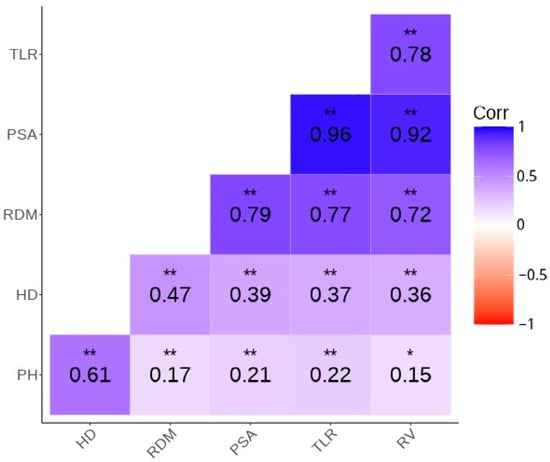
Figure 1
Open AccessArticle
Discriminating among Alternative Dressing Solutions for Cereal Seed Treatment: Effect on Germination and Seedling Vigor of Durum Wheat
by
Angelo Rossini, Roberto Ruggeri and Francesco Rossini
Int. J. Plant Biol. 2024, 15(2), 230-241; https://doi.org/10.3390/ijpb15020019 - 05 Apr 2024
Abstract
A prompt seed germination and emergence coupled with an excellent seedling vigor are highly desired features to ensure perfect crop establishment and subsequent vegetative growth. Seed dressing with pesticides represents the most common technology for enhancing seed performance after sowing, while little is
[...] Read more.
A prompt seed germination and emergence coupled with an excellent seedling vigor are highly desired features to ensure perfect crop establishment and subsequent vegetative growth. Seed dressing with pesticides represents the most common technology for enhancing seed performance after sowing, while little is known about biostimulant seed dressing. This practice could play a fundamental role in developing new sustainable starter fertilization for cereals. The enhancement of germination and seedling vigor of durum wheat seeds (Triticum turgidum L. subsp. durum (Desf.) Husn) was the main target of this research. The experiment took place in a germination cabinet under controlled environmental conditions, settled at the constant temperature of 10 °C and under dark conditions for 8 days. The different seed dressings, sprayed on the seeds, were composed by a combination of a fungicide and different biostimulants. Coleoptile and root length, as well as biomass, were significantly increased by the different biostimulants, compared to the control. As for germination traits, seeds treated with Codium fragile and Opuntia ficus-indica extracts, containing phytohormones and different nutrients, showed a final germination (96%) significantly higher than the one obtained with the control treatment (86%). These results show that treating seeds with a suitable dressing solution can greatly improve the germination features and seedling vigor of durum wheat. This can help the crop to withstand future stresses, especially in early stages, and possibly increase the grain yield with a reduction in agrochemicals. However, the combination of the substances used in the present study rarely showed a synergistic effect on the tested variable.
Full article
(This article belongs to the Section Plant Reproduction)
►▼
Show Figures
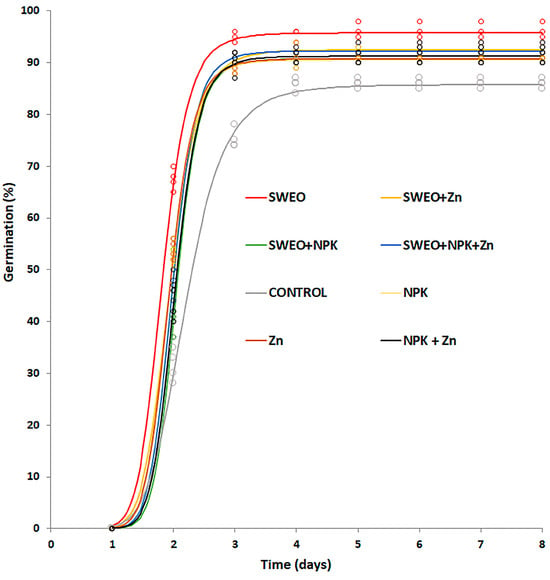
Figure 1
Open AccessArticle
Eggplant Little Leaf-Associated Phytoplasma Detection in Seedlings under Insect-Proof Conditions
by
Mukesh Darabakula, Sri Tej Mateeti, Francesco Pacini, Assunta Bertaccini and Nicoletta Contaldo
Int. J. Plant Biol. 2024, 15(2), 217-229; https://doi.org/10.3390/ijpb15020018 - 27 Mar 2024
Abstract
Eggplant, or brinjal, is one of the most consumed and important tropical solanaceous vegetable crops grown worldwide. Little leaf is a disease associated with the presence of phytoplasmas especially widespread in brinjal in India. To clarify the epidemiology of this disease, a verification
[...] Read more.
Eggplant, or brinjal, is one of the most consumed and important tropical solanaceous vegetable crops grown worldwide. Little leaf is a disease associated with the presence of phytoplasmas especially widespread in brinjal in India. To clarify the epidemiology of this disease, a verification of its transmission through seeds to seedlings and their progeny derived from symptomatic mother plants was performed. Brinjal seeds field-collected in the Dharwad district of Karnataka State, India, were sowed in a greenhouse under insect-proof conditions. DNA was extracted from seedlings and their progeny and from symptomatic plant samples collected in the field. The first- and second-generation seedlings obtained *under these conditions were tested at various time points after germination by amplification of the 16S rRNA gene of phytoplasmas. The amplicons obtained were subjected to restriction fragment length polymorphism (RFLP) analysis and sequencing for the identification of detected phytoplasmas. Ribosomal groups 16SrI, 16SrII, 16SrIII, 16SrV, 16SrVI, and 16SrXII were identified. Moreover, a number of fruits produced from the first-generation seedlings showed precocious seed germination, and the young seedlings resulted as phytoplasma-positive. The seed transmission of phytoplasmas in eggplants for two subsequent generations highlights the risk of additional sources of infection of the disease represented by asymptomatic and infected seedlings in the presence of insect vectors. The seed transmission could explain the continuous presence of epidemic outbreaks of phytoplasmas in brinjal cultivations in several cultivation areas.
Full article
(This article belongs to the Section Plant–Microorganisms Interactions)
►▼
Show Figures
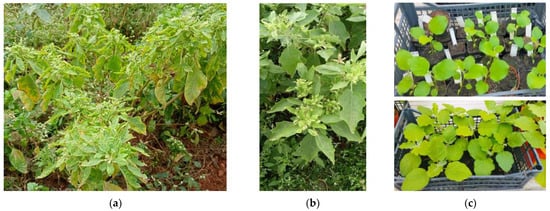
Figure 1
Open AccessArticle
Genetic Variability and Clustering Patterns of Sugarcane (Saccharum spp.) Germplasms with Respect to Sucrose-Related Traits
by
Aliya Momotaz, Orlando Coto Arbelo, Vanessa S. Gordon, Bronski Wesley, Sushma G. Sood and Duli Zhao
Int. J. Plant Biol. 2024, 15(2), 203-216; https://doi.org/10.3390/ijpb15020017 - 26 Mar 2024
Abstract
Fifty-five sugarcane genotypes from around the world were collected and evaluated for potential use as parental material in the USDA ARS Canal Point (CP) sugarcane breeding program in Florida, USA. The genotypes were planted in a trial with four check cultivars on organic
[...] Read more.
Fifty-five sugarcane genotypes from around the world were collected and evaluated for potential use as parental material in the USDA ARS Canal Point (CP) sugarcane breeding program in Florida, USA. The genotypes were planted in a trial with four check cultivars on organic soils with four replications, and data were collected for two years [i.e., plant cane (PC) and first ratoon (FR) crops] to assess sucrose-yield-related traits and the cane-yield-related traits in PC. Using a multivariate analysis, variation was observed in all cane—[i.e., stalk weight, stalk population and cane yield] and sugar-yield-related traits [i.e., Brix, Pol, sucrose content and commercial recoverable sucrose (CRS)]. The mean CRS content was greater in the FR crop than the PC crop. Significant variations were attributed to genotype (G), crop cycles (C) and G × C effects. Variations between crop cycles were highly significant for all sucrose yield components, which could complicate the downstream selection of genotypes for sucrose yield. Based on CRS content, genotypes could be grouped into six distinct clusters. Based on plant cane data, cane yield traits (stalk weight, stalk population and cane yield) were used to estimate the breeding values of parents. Of the 55 genotypes, 8 had significantly greater t-BLUP values for cane yield, along with CP 00-1101. Combined sucrose yield traits, (Brix, Pol and sucrose content) from the two crops were used to estimate the breeding values of parents. Of the 55 genotypes, 10 genotypes had significantly greater t-BLUP values for CRS, along with CP 00-1101, CP 96-1252 and CP 01-2390, and can be considered as elite parents in future breeding efforts. These results provide a foundation for the efficient integration of genetic diversity in developing commercial cultivars, with improved sucrose yields, into the CP sugarcane breeding program.
Full article
(This article belongs to the Section Plant Biochemistry and Genetics)
►▼
Show Figures
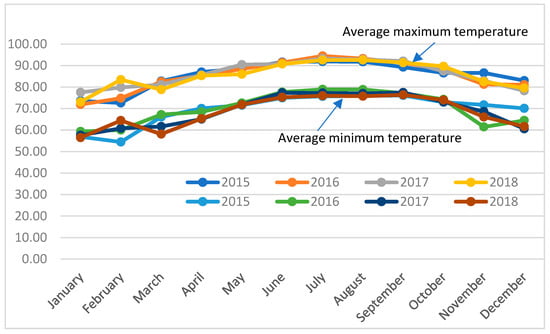
Figure 1
Open AccessCommentary
Calcium-Mediated Modulation of GC Switch Regulates Peroxisomal H2O2 Levels in Response to Wounding in Plants
by
Ishu, Jyoti Shekhawat and Santosh Kumar Upadhyay
Int. J. Plant Biol. 2024, 15(1), 198-202; https://doi.org/10.3390/ijpb15010016 - 13 Mar 2024
Abstract
Ca2+ and H2O2 interact with each other to regulate plant systemic responses. However, their precise mechanism is not fully understood. A recent study revealed that the Ca2+ regulates the glycolate oxidase-catalase (GC) switch-mediated photorespiratory H2O2
[...] Read more.
Ca2+ and H2O2 interact with each other to regulate plant systemic responses. However, their precise mechanism is not fully understood. A recent study revealed that the Ca2+ regulates the glycolate oxidase-catalase (GC) switch-mediated photorespiratory H2O2 during wounding. Glutamate-receptor-like (GLR) Ca2+ channels (GLR 3.3 and GLR3.6) are responsible for Ca2+ influx during injury for regulation of the GC switch. Mechanical injury quickly shifts the GC switch to a highly interactive state in the systemic leaves that ultimately results in the reduced peroxisomal H2O2. However, the mechanism of H2O2 reduction in peroxisome remains elusive.
Full article
(This article belongs to the Section Plant Communication)
►▼
Show Figures
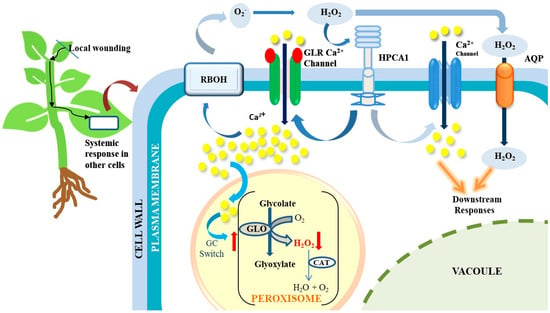
Figure 1
Open AccessArticle
Evaluating Growth and Physiological Responses of a Medicinal Plant Phyla nodiflora to Salinity
by
Anh Cong Pham, Tuan Chau Vo, Thang Duc Bui, Thi-Thao Hien Van and Dan Quang Tran
Int. J. Plant Biol. 2024, 15(1), 187-197; https://doi.org/10.3390/ijpb15010015 - 12 Mar 2024
Abstract
Phyla nodiflora is a valuable medicinal plant growing in coastal areas, hypothesizing its adaptability to salinity; however, it has not been investigated. This study, for the first time, elucidated responses in the growth of the shoots and its physiology to different soil salinity
[...] Read more.
Phyla nodiflora is a valuable medicinal plant growing in coastal areas, hypothesizing its adaptability to salinity; however, it has not been investigated. This study, for the first time, elucidated responses in the growth of the shoots and its physiology to different soil salinity of 50–400 mM NaCl. The data showed that the shoot’s dry biomass was not affected by the salinity levels up to 100 mM, and it only decreased 33.50–56.33% compared to the control under 200–400 mM NaCl, indicating that P. nodiflora is a salt-tolerant plant that could survive under high salinity. In addition, the plant also had physiological responses which indicated its salt-induced injuries and adaptation to the salt stress. The chlorophyll a content was increased while the chlorophyll b remained unchanged under the salt stress. The proline and salt accumulation increased under the salinity, but the K+ and NO3− accumulation decreased. Moreover, increases in malondialdehyde and electrolyte leakage were observed, indicating salt-induced membrane damages. These responses suggested that the plant might evolve adaptive mechanisms to salinity. Our findings are useful information for further research in order to elucidate the salt-tolerant mechanisms and develop this plant for saline agriculture.
Full article
(This article belongs to the Topic Tolerance to Drought and Salt Stress in Plants)
►▼
Show Figures
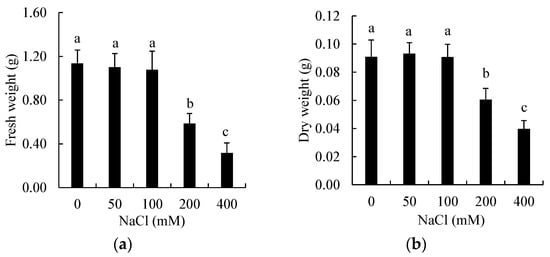
Figure 1
Open AccessArticle
Secondary Metabolites and Their Antioxidant Activity Enhance the Tolerance to Water Deficit on Clover Lotus corniculatus L. through Different Seasonal Times
by
Luis Angel González-Espíndola, Aurelio Pedroza-Sandoval, Gabino García de los Santos, Ricardo Trejo-Calzada, Perpetuo Álvarez-Vázquez and Maria del Rosario Jacobo-Salcedo
Int. J. Plant Biol. 2024, 15(1), 175-186; https://doi.org/10.3390/ijpb15010014 - 04 Mar 2024
Abstract
This study aimed to evaluate the effects of a water limitation in different ecotypes and one variety of Lotus corniculatus L. on the production of secondary metabolites and their antioxidant activity in response to a water deficit (WD) through other seasonal times. A
[...] Read more.
This study aimed to evaluate the effects of a water limitation in different ecotypes and one variety of Lotus corniculatus L. on the production of secondary metabolites and their antioxidant activity in response to a water deficit (WD) through other seasonal times. A randomized block experimental design with three replicates was used. Two levels of soil water content and five genotypes were arranged in a factorial way (2 × 5) with ten treatments for replication. The 255301 ecotype showed significantly higher (p ≤ 0.05) concentrations of total phenols, with a concentration of 86.6 mg Gallic Acid Equivalent (GAE)/gram of fresh weight (gFW); total flavonoids, with a concentration of 63.2 mg Quercetin Equivalent (QE)/gFW); total tannins (71.7 mg GAE/gFW); and radical scavenging activity, with an average of 200 mg Trolox Equivalent Antioxidant Capacity (TEAC)/gFW) in winter under a WD. The 255305 ecotype showed an increase in radical scavenging activity of 230 mg (TEAC)/gFW) and a total tannin concentration of 65.3 mg GAE/gFW in winter and spring, respectively, under a WD. The 255301 ecotype showed an increase in the concentration of total saponins (254.8 mg saponins/gFW) in summer under a WD. All these responses were triggered to mitigate a water deficit and extreme temperatures.
Full article
(This article belongs to the Section Plant Response to Stresses)
►▼
Show Figures
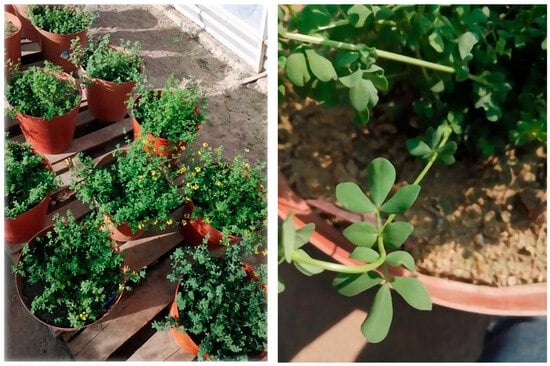
Figure 1
Open AccessReview
Isoprene: An Antioxidant to Guard Plants against Stress
by
Perumalla Srikanth, Ann Maxton, Sam A. Masih, Adriano Sofo and Nafees A. Khan
Int. J. Plant Biol. 2024, 15(1), 161-174; https://doi.org/10.3390/ijpb15010013 - 29 Feb 2024
Abstract
Isoprene, a lipophilic and unstable compound with the chemical formula C5H8, is transported to plant chloroplasts via the 2-C-methyl-d-erythritol 4-phosphate (MEP) pathway, which relies on photosynthesis. Although only about 20% of terrestrial plants can synthesize isoprene, those that emit it are
[...] Read more.
Isoprene, a lipophilic and unstable compound with the chemical formula C5H8, is transported to plant chloroplasts via the 2-C-methyl-d-erythritol 4-phosphate (MEP) pathway, which relies on photosynthesis. Although only about 20% of terrestrial plants can synthesize isoprene, those that emit it are more adaptable to oxidative and thermal stresses. To shed light on the still-elusive protective mechanism of isoprene, numerous investigations have been conducted. Isoprene has been shown to react with and quench various reactive oxygen species (ROS) such as singlet oxygen (1O2). Its reduced state and conjugated double bonds suggest that it functions as an antioxidant, although this has yet to be conclusively proven. Despite its low abundance relative to other molecules in plant tissues, recent research has explored several potential roles for isoprene including acting as a scavenger of ROS by serving as an antioxidant; strengthening cell membranes; modulating genomic, proteomic and metabolomic profiles; signaling stress responses among neighboring plants compared with other volatile organic compounds (VOCs); regulating metabolic fluxes of hormones produced through the MEP pathway; or even functioning as a free developmental hormone. Future prospective studies, such as identifying the specific receptors for VOCs along with transcription factors (TFs) and other regulatory proteins participating in the signaling pathways and also metabolomic, transcriptomic and physiological analyses could help in comprehending VOC-induced defense responses in plants under stress conditions.
Full article
(This article belongs to the Section Plant Communication)
►▼
Show Figures
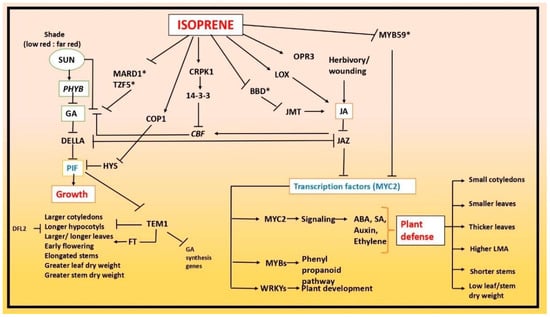
Figure 1
Open AccessReview
Structure and Trends of Worldwide Research on Durum Wheat by Bibliographic Mapping
by
Antonio Blanco
Int. J. Plant Biol. 2024, 15(1), 132-160; https://doi.org/10.3390/ijpb15010012 - 17 Feb 2024
Abstract
The bibliometric mapping approach is a quantitative methodology to analyze the structure and evolution of research activities in a scientific area or a discipline. The objective of the current study was to perform a bibliometric analysis of the worldwide durum wheat literature published
[...] Read more.
The bibliometric mapping approach is a quantitative methodology to analyze the structure and evolution of research activities in a scientific area or a discipline. The objective of the current study was to perform a bibliometric analysis of the worldwide durum wheat literature published from 1961 to 2022 to identify topics and trends and their evolution over time. A total of 7512 documents were analyzed to generate bibliometric maps illustrating the main research topics. Most of the articles (91.6%) were published in indexed journals, with a low percentage (3.4%) in conference proceedings. The most active journals were the Journal of Cereal Science, Euphytica, Theoretical and Applied Genetics, Cereal Research Communications, and Cereal Chemistry. Italy, the USA, Canada, Spain, and France were the countries publishing the most documents. Research interests were focused on mutagenesis, interspecific hybridization, and technological quality in 1961–1980 and moved to conservation farming, molecular genetics, and nutritional quality in the last two decades. Future durum wheat production is facing challenges from climate change, water scarcity, and rising demand for sustainable food production. Advancements in molecular breeding techniques, genome editing, precision agriculture, and conservation farming can expedite wheat improvement and pave the way toward a healthier environment. The analysis of a large amount of bibliographic data provides useful information for researchers and policymakers and represents a starting point for a comprehensive discussion for future research.
Full article
(This article belongs to the Section Plant Physiology)
►▼
Show Figures
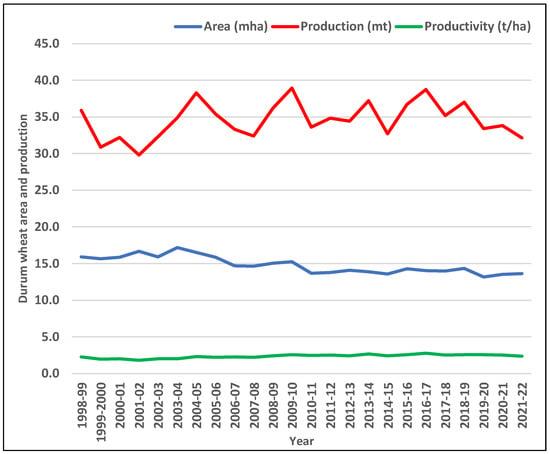
Figure 1
Open AccessBrief Report
Analysis of the Time Course of the Establishment of Systemic Gene Silencing by Barley Stripe Mosaic Virus Virus-Induced Gene Silencing in Wheat
by
Anshu Garg, Amanda S. Brandt and Steven R. Scofield
Int. J. Plant Biol. 2024, 15(1), 122-131; https://doi.org/10.3390/ijpb15010011 - 14 Feb 2024
Abstract
Wheat is one of the major sources of protein worldwide. Its hexaploidy significantly complicates the identification of genes that may be crucial for improving wheat production to meet the challenges of an increased world population and climate change. Virus-induced gene silencing (VIGS) using
[...] Read more.
Wheat is one of the major sources of protein worldwide. Its hexaploidy significantly complicates the identification of genes that may be crucial for improving wheat production to meet the challenges of an increased world population and climate change. Virus-induced gene silencing (VIGS) using Barley stripe mosaic virus (BSMV)-based constructs has proven to be a very useful tool in the analysis of gene function in the hexaploid plant, wheat. However, most published applications of this technique focus on phenotypes that can be observed in the leaves of wheat. A few studies have reported successful VIGS in the spikes of wheat, but this has proven to be more difficult than the seedling leaf assays. This study reports a time course analysis of the movement of BSMV from the site of inoculation into the meristematic region of wheat. It also describes how the photobleaching phenotype resulting from silencing phytoene desaturase (PDS), which is often used as a reporter for VIGS, does not indicate the full extent of where VIGS occurs, and this can mislead scientists as they design silencing studies. These findings provide guidance for more effective VIGS studies to determine the function of genes expressed in the spikes of wheat and may be important for wheat improvement.
Full article
(This article belongs to the Section Plant–Microorganisms Interactions)
►▼
Show Figures

Figure 1
Open AccessArticle
Effect of Herbicides on Forage Dry Matter Yield and Plant Density in the Old Arable Lands in Communal Area of the Eastern Cape Province, South Africa
by
Wandile Mashece, Solomon Tefera Beyene, Mthunzi Mndela, Gideon Jordaan, Unathi Gulwa and Sive Tokozwayo
Int. J. Plant Biol. 2024, 15(1), 110-121; https://doi.org/10.3390/ijpb15010010 - 29 Jan 2024
Abstract
With the world’s population growing at an alarming rate, there is an urgent need to improve food security. This study aimed to assess forage dry matter yield and plant density under different herbicide treatments at Kubedlana arable lands. The study was carried out
[...] Read more.
With the world’s population growing at an alarming rate, there is an urgent need to improve food security. This study aimed to assess forage dry matter yield and plant density under different herbicide treatments at Kubedlana arable lands. The study was carried out using eight treatments consisting of seven herbicide treatments and a control. Seed mixtures of seven legume species were broadcasted in 24 plots of 3 m × 5 m size. Herbicide treatments including Bendioxide (BEN), Glyphosate (GLY), Haloxyfop-R methyl (HAL), Haloxyfop-R methyl and Bendioxide (HBE), Paraquat (PAR), Bendioxide (BRR), and Paraquat (PRR) were applied individually in three plots. Dry matter production and plant densities were determined in five randomly distributed 0.25 m2 quadrats per plot. The results revealed that GLY had a significantly (p < 0.05) higher effect on the DM yield compared with other treatments. Both BRR and HBE significantly (p < 0.05) decreased the DM yield. GLY and HBE significantly reduced (p < 0.05) the grass density in 2017 and BRR significantly affected (p < 0.05) the legume density in May 2017 and May 2018, respectively. These results indicate that the application of GlY and HAL resulted in the reduction of grass density. Furthermore, none of the applied chemicals negatively influenced the legume density.
Full article
(This article belongs to the Section Plant Ecology and Biodiversity)
►▼
Show Figures

Figure 1
Open AccessTechnical Note
LeafArea Package: A Tool for Estimating Leaf Area in Andean Fruit Species
by
Pedro Alexander Velasquez-Vasconez and Danita Andrade Díaz
Int. J. Plant Biol. 2024, 15(1), 102-109; https://doi.org/10.3390/ijpb15010009 - 29 Jan 2024
Abstract
The LeafArea package is an innovative tool for estimating leaf area in six Andean fruit species, utilizing leaf length and width along with species type for accurate predictions. This research highlights the package’s integration of advanced machine learning algorithms, including GLM, GLMM, Random
[...] Read more.
The LeafArea package is an innovative tool for estimating leaf area in six Andean fruit species, utilizing leaf length and width along with species type for accurate predictions. This research highlights the package’s integration of advanced machine learning algorithms, including GLM, GLMM, Random Forest, and XGBoost, which excels in predictive accuracy. XGBoost’s superior performance is evident in its low prediction errors and high R2 value, showcasing the effectiveness of machine learning in leaf area estimation. The LeafArea package, thus, offers significant contributions to the study of plant growth dynamics, providing researchers with a robust and precise tool for informed decision making in resource allocation and crop management.
Full article
(This article belongs to the Section Application of Artificial Intelligence in Plant Biology)
►▼
Show Figures
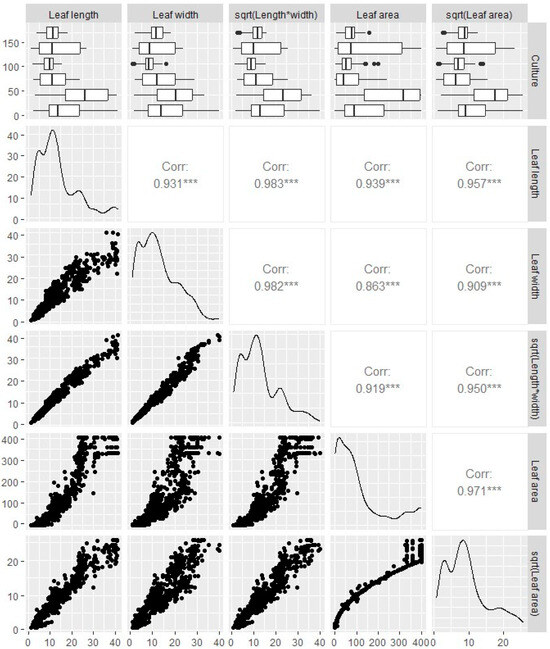
Figure 1
Open AccessBrief Report
The Response of Botrytis cinerea to Fire in a Coast Redwood Forest
by
Damiana S. Rojas and Gregory S. Gilbert
Int. J. Plant Biol. 2024, 15(1), 94-101; https://doi.org/10.3390/ijpb15010008 - 24 Jan 2024
Abstract
Coast redwoods (Sequoia sempervirens) are long-lived trees that create deep shade and litter layers, and have limited recruitment from seedlings. Botrytis cinerea is an airborne fungal pathogen that attacks redwood seedlings. B. cinerea lives as a saprotroph in dead plant matter
[...] Read more.
Coast redwoods (Sequoia sempervirens) are long-lived trees that create deep shade and litter layers, and have limited recruitment from seedlings. Botrytis cinerea is an airborne fungal pathogen that attacks redwood seedlings. B. cinerea lives as a saprotroph in dead plant matter or as a necrotroph in live tissue. In the coast redwood forest, accumulated leaf litter may provide inoculum for subsequent infections, limiting redwood seedling recruitment. Here, we examine the response of B. cinerea to fire in the coast redwood forest. We measured the abundance of airborne B. cinerea spores in paired burned and unburned plots using a selective and diagnostic medium. In a greenhouse experiment, we grew seedlings in four different treatments: (1) burned soil with no leaf litter, (2) unburned soil with no leaf litter, (3) burned soil with leaf litter collected from the burn plot, (4) unburned soil with leaf litter collected from the unburned plot. Spore trapping showed no difference in the abundance of airborne spores in the paired plots. The seedling experiment showed that disease was greatest and survival lowest when grown in burned soil; leaf litter collected from burned plots reduced survival while leaf litter from not-burned plots increased survival. These results indicate that fire did not affect airborne B. cinerea and post-fire conditions did not provide favorable growth conditions for coast redwood seedlings.
Full article
(This article belongs to the Section Plant–Microorganisms Interactions)
►▼
Show Figures

Figure 1
Highly Accessed Articles
Latest Books
E-Mail Alert
News
Topics
Topic in
Antioxidants, IJPB, Molecules, Pharmaceuticals, Plants
Plants Volatile Compounds
Topic Editors: Dario Kremer, Igor Jerković, Valerija DunkićDeadline: 30 April 2024
Topic in
Agronomy, Diversity, Forests, IJPB, Plants
Plant Invasion
Topic Editors: Bruce Osborne, Panayiotis G. DimitrakopoulosDeadline: 31 July 2024
Topic in
Agriculture, Agronomy, Crops, Microorganisms, Plants, IJPB, Soil Systems
Microbe-Induced Abiotic Stress Alleviation in Plants
Topic Editors: Ying Ma, Christopher RensingDeadline: 30 September 2024
Topic in
Agronomy, Horticulturae, IJPB, Life, Plants
Effects of Climate Change on Viticulture (Grape)
Topic Editors: Arif Atak, Andreia Figueiredo, Inmaculada Pascual, Fermin MoralesDeadline: 31 December 2024

Conferences
Special Issues
Special Issue in
IJPB
Recent Advances in the Effects of Biotic and Abiotic Stressors on Plant Secondary Metabolites
Guest Editor: Mohamed AddiDeadline: 5 June 2024


